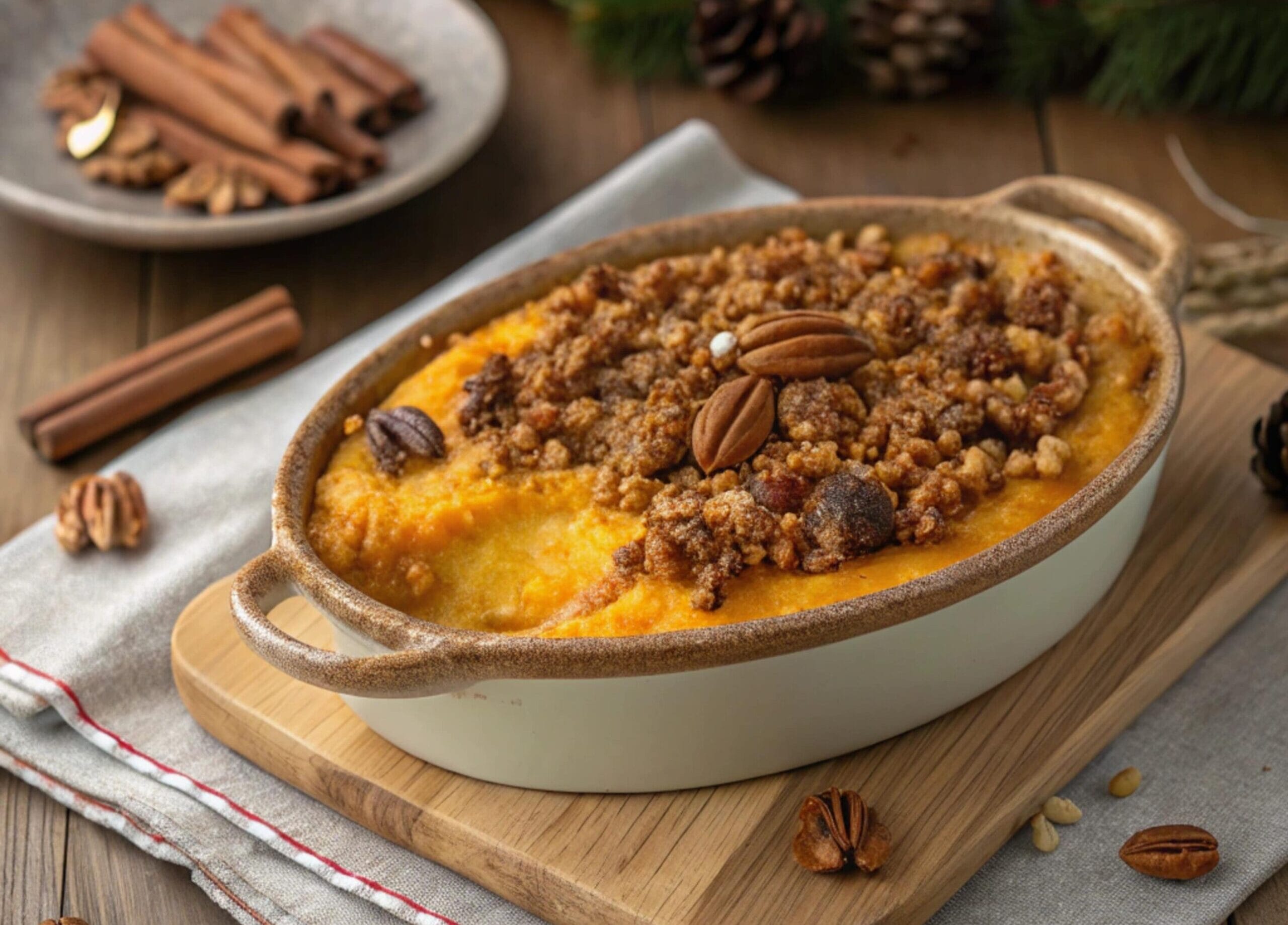Introduction to Martha Stewart Sweet Potato Casserole
Martha Stewart sweet potato casserole is a timeless holiday favorite, blending tradition, flavor, and elegance. This classic dish is cherished for its creamy texture and perfectly balanced sweetness, making it a staple for festive gatherings. Furthermore, it seamlessly combines comfort food with gourmet sophistication.
Whether you’re preparing it for a family dinner or a festive event, this dish is guaranteed to impress everyone at the table. As a result, it has become a go-to recipe for many during the holiday season. Its versatility allows for creative variations, ensuring there’s a version for every preference. With simple ingredients and expert techniques, this casserole remains a cherished part of holiday traditions.
For a classic twist, visit the Old-Fashioned Sweet Potato Casserole recipe. This variation focuses on traditional flavors and techniques.
Ingredients Needed for Martha Stewart Sweet Potato Casserole
To craft this delicious Martha Stewart Sweet Potato Casserole, you will need several pantry staples along with a few high-quality ingredients to enhance the flavor and texture.
For the Sweet Potato Base:
- 4 large sweet potatoes (peeled, cubed, and boiled)
- ½ cup unsalted butter (melted)
- ½ cup granulated or brown sugar (adjust to taste)
- 2 large eggs (lightly beaten)
- ½ cup whole milk or cream
- 1 teaspoon vanilla extract
- ½ teaspoon ground cinnamon
- ¼ teaspoon nutmeg (optional for added depth)
For the Topping:
- 1 cup chopped pecans or walnuts
- ½ cup brown sugar
- ⅓ cup all-purpose flour
- ⅓ cup unsalted butter (melted)
- Optional: 1 cup mini marshmallows for added sweetness
In addition, fresh spices and premium-quality butter will elevate the flavor of Martha Stewart Sweet Potato Casserole significantly. Moreover, using whole milk or cream ensures a rich and luscious texture. Therefore, make sure to choose fresh and high-quality ingredients for the best results.

Step-by-Step Instructions for Making the Martha Stewart sweet potato casserole
Creating Martha Stewart sweet potato casserole is straightforward. By following these steps, you’ll achieve a perfectly creamy and flavorful dish every time:
1. Prepare the Sweet Potatoes
First, preheat your oven to 350°F (175°C). Then, peel and cube the sweet potatoes before boiling them in salted water. Cook until tender, which should take around 15–20 minutes. Once boiled, drain them thoroughly and set them aside.
2. Mash the Sweet Potatoes
Next, transfer the sweet potatoes to a large mixing bowl. Mash them until smooth, and then add the melted butter, sugar, eggs, milk, vanilla extract, cinnamon, and nutmeg. Stir until all the ingredients are well combined.
3. Assemble the Casserole
After mixing the base, lightly grease a 9×13-inch baking dish. Spread the sweet potato mixture evenly in the dish, ensuring a smooth surface with a spatula.
4. Prepare the Topping
Meanwhile, mix the chopped nuts, brown sugar, flour, and melted butter in a separate bowl. Stir the mixture until it resembles coarse crumbs. Optionally, layer marshmallows on top for a gooey finish.
5. Bake the Casserole
Finally, place the dish in the preheated oven and bake for 30–40 minutes. Ensure the topping becomes golden brown and the casserole bubbles at the edges. Once done, let it cool for about 5–10 minutes before serving.
By following these steps, you’ll create a Martha Stewart sweet potato casserole that combines creamy richness with a delightful crunch on top. Additionally, the flavors will meld beautifully, ensuring a dish that everyone will love.
Tips for Perfecting Martha Stewart Sweet Potato Casserole
To take your casserole to the next level, consider the following tips:
- Use Fresh Ingredients:
Always use fresh sweet potatoes for maximum flavor. While canned sweet potatoes can work, they often lack the natural sweetness of fresh ones. - Adjust the Sweetness:
If you prefer a less sweet casserole, reduce the amount of sugar in the base. Conversely, for those with a sweet tooth, drizzle some maple syrup over the top before serving. - Experiment with Toppings:
Feel free to swap out the nut topping with crushed graham crackers or oats for a different texture. - Avoid Overbaking:
Overbaking can dry out the casserole, so keep an eye on the oven. Check for doneness by inserting a toothpick into the center—it should come out clean. - Add Unique Flavors:
For a more distinctive taste, try adding orange zest or a splash of bourbon to the sweet potato base.
By implementing these tips, your casserole will consistently turn out flawless. Moreover, these adjustments allow for greater customization, making the dish uniquely yours.
Variations on Martha Stewart Sweet Potato Casserole
Although the traditional Martha Stewart Sweet Potato Casserole is a classic favorite, there are many ways to modify it to suit different tastes, dietary needs, and personal preferences. Whether you enjoy a sweeter version, prefer a healthier adaptation, or want to try something completely new, these variations ensure there’s a perfect option for everyone.
1. Classic Marshmallow Topping
For those who love a sweet and gooey texture, replacing the traditional nutty crumble with mini marshmallows is a great option. The marshmallows caramelize as they bake, forming a golden, slightly crispy layer that contrasts beautifully with the creamy base of Martha Stewart Sweet Potato Casserole.
To achieve the best results:
Arrange mini marshmallows evenly over the casserole before baking.
Bake until the marshmallows turn golden brown and slightly toasted.
For an extra indulgent twist, drizzle with a bit of maple syrup or honey before serving.
This version is especially popular with kids and those who love a nostalgic take on Martha Stewart Sweet Potato Casserole.
2. Gluten-Free Version
For those with gluten sensitivities, this variation maintains the rich, comforting flavors while making the dish safe to enjoy.
Substitute all-purpose flour with gluten-free flour or almond flour for the topping.
Ensure that all other ingredients, such as vanilla extract and spices, are certified gluten-free.
Use cornstarch instead of flour if the filling needs thickening.
With these simple swaps, you can create a gluten-free version of Martha Stewart Sweet Potato Casserole that tastes just as delicious as the original.
3. Vegan Adaptation
A plant-based version of Martha Stewart Sweet Potato Casserole is just as creamy and satisfying without using dairy or eggs. By making a few key substitutions, you can create a completely vegan-friendly dish.
Swap out regular milk for almond, oat, or coconut milk.
Replace butter with vegan butter or coconut oil for a rich texture.
Use flaxseed meal mixed with water as an egg alternative.
Opt for a pecan or oat-based crumble instead of marshmallows for a dairy-free topping.
This version is ideal for those who follow a vegan diet but still want to enjoy the comforting flavors of Martha Stewart Sweet Potato Casserole.
4. Savory Sweet Potato Casserole
For those who prefer savory flavors over sweet, this variation transforms Martha Stewart Sweet Potato Casserole into a side dish with a rich, herby twist.
Reduce or omit sugar from the filling to enhance the natural sweetness of the potatoes.
Incorporate fresh herbs like thyme, rosemary, or sage for depth of flavor.
Add garlic and caramelized onions to balance the sweetness.
Mix in grated Parmesan or sharp cheddar for a cheesy finish.
This savory version pairs beautifully with roast turkey, chicken, or beef, making it an excellent option for those who enjoy more complex flavors in their Martha Stewart Sweet Potato Casserole.
5. Spiced Holiday Variation
For a warm, spiced version that’s perfect for the holiday season, try enhancing Martha Stewart Sweet Potato Casserole with classic seasonal spices.
Add cinnamon, nutmeg, allspice, or cloves to the sweet potato mixture.
Stir in a splash of orange juice or zest for a bright, citrusy note.
Top with a brown sugar and pecan crumble for extra crunch.
This version adds warmth and complexity, making it ideal for Thanksgiving, Christmas, or any festive occasion.
These creative variations on Martha Stewart Sweet Potato Casserole allow you to personalize the dish based on dietary preferences and flavor preferences. Whether you prefer a sweet, cheesy, gluten-free, vegan, or savory version, there’s a perfect adaptation for everyone.
No matter which variation you choose, Martha Stewart Sweet Potato Casserole remains a versatile and comforting dish that can be customized for any occasion. Try experimenting with these different versions and discover your new favorite way to enjoy this holiday classic!

The Nutritional Profile of Martha Stewart Sweet Potato Casserole
Understanding the nutritional value of this dish allows for mindful indulgence:
Calories and Macronutrients:
- A standard serving contains approximately 250–300 calories, depending on the toppings used.
- Rich in healthy carbohydrates, it provides sustained energy, making it ideal for festive meals.
Key Nutrients:
- Vitamin A: Sweet potatoes are loaded with beta-carotene, which supports eye health.
- Fiber: This dish provides a moderate amount of fiber, promoting digestion.
- Potassium: Essential for heart health and muscle function.
Lightening the Recipe:
- Opt for low-fat milk and reduce the butter to cut calories.
- Substitute brown sugar with natural sweeteners like honey or coconut sugar.
By understanding the nutritional aspects, you can enjoy Martha Stewart sweet potato casserole guilt-free while keeping your diet balanced. Moreover, small modifications can make the casserole even healthier without compromising on taste.
Martha Stewart sweet potato casserole is more than just a recipe—it’s a celebration of flavors, textures, and family traditions. With its creamy base and crunchy topping, it’s perfect for any holiday table. Furthermore, by using the tips and variations provided, you can tailor it to suit any occasion or dietary need. Prepare it this season and enjoy a timeless dish that never fails to impress!
If you’re planning a full holiday meal, consider serving your casserole alongside a savory side dish like Corn Casserole Pioneer Woman: A Southern Classic.
Pairing Ideas: What to Serve with This Casserole
Martha Stewart sweet potato casserole shines on its own, but pairing it with complementary dishes elevates your meal. Here are some ideal options:
- Roasted Turkey or Glazed Ham: The savory flavors of roasted meats balance the natural sweetness of Martha Stewart sweet potato casserole.
- Green Bean Casserole: Add a fresh, crunchy vegetable side to contrast the creamy texture.
- Cranberry Sauce: The tangy sweetness of cranberry sauce pairs beautifully with the casserole.
- Dinner Rolls or Cornbread: These bread options soak up every bit of the casserole’s goodness.
For beverage options, consider serving spiced cider or mulled wine to complete the festive vibe. Pairing Martha Stewart sweet potato casserole thoughtfully ensures a well-rounded meal your guests will love.
For a unique dessert pairing, the Dubai Chocolate Bar Recipe: Luxurious and Irresistible offers a sophisticated conclusion to your holiday meal.
FAQs
How can you prepare sweet potatoes using Martha Stewart’s method?
Martha Stewart sweet potato casserole involves a few simple steps:
- Boil or bake sweet potatoes until tender.
- Mash the sweet potatoes with butter, brown sugar, eggs, and spices like cinnamon and nutmeg.
- Spread the mixture into a baking dish, then top with a pecan crumble or marshmallows.
- Bake at 350°F (175°C) until the topping is golden and the casserole is heated through.
For detailed instructions, check out Martha Stewart’s official recipe page here.
How can you prevent martha stewart sweet potato casserole from becoming too runny?
A runny casserole often results from excess moisture. To avoid this:
- Drain Properly: If boiling sweet potatoes, ensure they are thoroughly drained.
- Don’t Overmix: Overmixing can release excess moisture from the potatoes.
- Measure Ingredients Carefully: Too much milk or liquid can dilute the casserole.
Additionally, baking the casserole at the recommended temperature allows any remaining moisture to evaporate.
Why do you soak sweet potatoes before baking?
Soaking sweet potatoes removes excess starch, resulting in:
- Improved Texture: For dishes like fries or roasted chunks, soaking ensures crispiness.
- Uniform Cooking: Soaking helps the potatoes cook evenly.
However, for mashed casseroles like Martha Stewart’s recipe, soaking is unnecessary since the potatoes are typically boiled or baked.
Should sweet potatoes be boiled or baked for the best casserole texture?
The method you choose depends on your priorities:
- Boiling: Faster and easier, boiling ensures the potatoes are tender for mashing. However, it can dilute flavors slightly.
- Baking: Baking enhances the natural sweetness of the potatoes and removes excess moisture, resulting in a richer flavor.
For the best results, bake sweet potatoes if time allows to elevate the dish’s flavor profile.
Why add eggs to Martha Stewart sweet potato casserole?
Eggs play a key role in sweet potato casseroles as they:
- Provide Structure: Eggs bind the ingredients together, ensuring the casserole holds its shape.
- Enhance Creaminess: They add a smooth, velvety texture to the dish.
Ensure the sweet potatoes are slightly cooled before adding eggs to avoid scrambling.
Boiling sweet potatoes typically takes 15–20 minutes, depending on the size of the pieces. You’ll know they’re ready when:
- A fork slides through the potatoes easily.
- The edges of the potatoes start to soften and break apart.
Cutting sweet potatoes into uniform pieces ensures even cooking and reduces boiling time.
Do sweet potatoes taste better baked or boiled?
Both methods have their advantages:
- Baked Sweet Potatoes: Offer a caramelized, richer flavor and firmer texture. Perfect for standalone dishes.
- Boiled Sweet Potatoes: Are softer and milder, ideal for mashing into casseroles.
Ultimately, baked sweet potatoes deliver more depth of flavor, while boiled ones work well for creamy dishes like casseroles.
Why are my sweet potatoes still hard after boiling?
Sweet potatoes may remain hard if:
- They weren’t cooked long enough. Extend the boiling time by 5–10 minutes.
- The potatoes are dense or old. Choose fresh sweet potatoes for faster, more even cooking.
For stubborn sweet potatoes, cut them into smaller pieces before boiling to speed up the process.
Do you add salt to water when boiling sweet potatoes?
Adding salt to boiling water is highly recommended because it:
- Enhances Flavor: Salt infuses the potatoes with subtle seasoning.
- Aids Cooking: Salt raises the water’s boiling point, leading to more evenly cooked potatoes.
A pinch of salt goes a long way, ensuring flavorful sweet potatoes even before mashing.
Conclusion: Why Martha Stewart Sweet Potato Casserole Stands Out
Martha Stewart sweet potato casserole is a timeless recipe, beloved for its creamy base and crunchy topping. Its versatility allows for endless pairings, while its rich, warm flavors capture the essence of holiday meals. What sets this dish apart is its balance of simplicity and sophistication. Whether you’re perfecting the texture or experimenting with variations, this casserole remains a standout addition to any festive table.
Beyond its classic appeal, Martha Stewart Sweet Potato Casserole can be easily adapted to suit different tastes and dietary preferences. Whether you choose to add a hint of maple syrup for extra sweetness, incorporate pecans for a nutty crunch, or swap in a dairy-free alternative, the possibilities are endless. Pairing it with roasted meats, fresh greens, or a crisp salad makes it a well-rounded addition to any holiday spread.
For those looking to explore more ways to prepare sweet potato casseroles, Allrecipes offers a collection of tested recipes, expert tips, and user reviews. Whether you’re trying this dish for the first time or refining your favorite version, having a reliable source of inspiration can make all the difference. Try this recipe and create a memorable dining experience that will impress your guests year after year.


4 thoughts on “How Do You Make Martha Stewart Sweet Potato Casserole?”